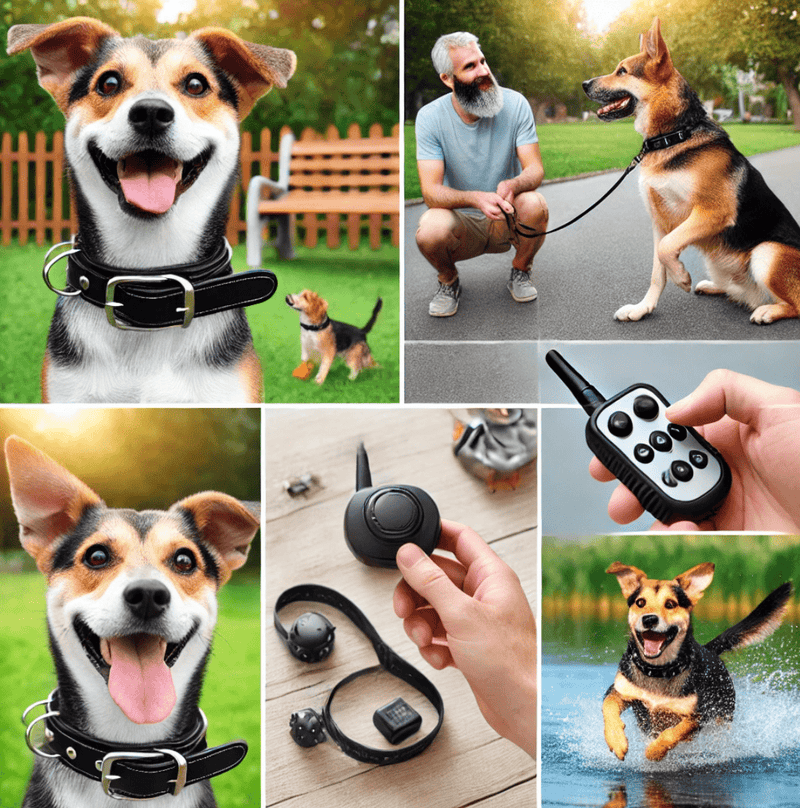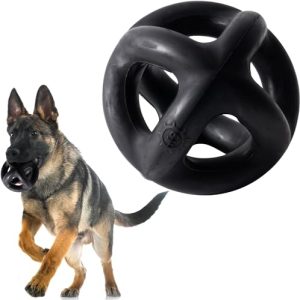Have you ever wondered if training collars are bad for your dog? You’re not alone.
Many pet owners grapple with this question. You want the best for your furry friend, ensuring their happiness and safety. But with so many opinions out there, it’s easy to feel overwhelmed. Imagine finding a clear answer that helps you make the right choice for your dog’s training.
We’ll explore the truth about training collars. We’ll uncover the pros and cons, and help you understand what’s best for your beloved pet. Dive in to discover insights that could change the way you think about dog training forever.
Types Of Training Collars
Training collars help dogs learn good behavior. They come in different types. Each type works in a different way.
Some collars give a gentle correction. Others use pressure or sound. It is important to know how each collar works.
Prong Collars
Prong collars have metal links with blunt prongs. They fit around the dog’s neck. When the dog pulls, the prongs press the skin.
These collars aim to mimic a mother dog’s bite. They cause discomfort but not injury. Some people find them useful for strong dogs.
Shock Collars
Shock collars deliver a small electric pulse. The pulse acts as a correction. It is controlled by a remote or the dog’s behavior.
These collars can stop bad habits quickly. Some dogs may feel scared or stressed by the shock. Use with care and training knowledge.
Slip Collars
Slip collars are made of a loop of metal or nylon. They tighten when the dog pulls on the leash. The collar loosens when the dog stops pulling.
They give a quick correction by tightening. Slip collars need careful use. Too tight or wrong fit can hurt the dog.
Martingale Collars
Martingale collars have two loops. One loop goes around the neck. The other loop tightens the collar if the dog pulls.
They prevent dogs from slipping out of the collar. They apply gentle pressure. Martingales are safer for dogs with narrow heads.

Credit: smart.dhgate.com
How Training Collars Work
Training collars help teach dogs how to behave. They give signals to get the dog’s attention.
These collars use different methods to guide dogs during training sessions.
Mechanism Of Action
Training collars send a stimulus when the dog does something wrong. The dog learns to connect the action with the signal.
Common types include vibration, sound, and mild static shocks. These signals aim to get the dog’s attention quickly.
- Vibration collars buzz to alert the dog
- Sound collars emit a beep or tone
- Static collars give a low-level electric pulse
Intended Benefits
Training collars can help stop bad behaviors like barking or pulling on the leash. They can speed up learning.
These collars allow owners to train dogs from a distance. They can improve communication between dog and owner.
- Quickly gains dog’s attention
- Helps with obedience training
- Useful for recall and control
- Works from a distance
Potential Risks
Training collars may cause fear or stress if used wrong. Dogs might feel pain or confusion.
Some dogs react badly to shock collars. Poor use can harm the dog’s trust and well-being.
- Possible physical discomfort
- Risk of increased anxiety or fear
- Can damage owner-dog bond
- Not suitable for all dogs
Pros Of Using Training Collars
Training collars can help dog owners guide their pets’ behavior. They offer a way to communicate commands clearly.
Used correctly, these collars support training and improve obedience. They can be a useful tool for many dogs.
Effective Behavior Control
Training collars help control unwanted behaviors quickly and safely. They give owners a way to correct dogs from a distance.
This control helps dogs learn boundaries and follow rules. It can reduce issues like pulling or jumping.
Quick Correction
These collars provide immediate feedback to dogs. Quick correction helps dogs understand which behaviors to avoid.
Immediate signals make training clearer and more effective. Dogs can connect their actions with the correction fast.
Useful For Specific Issues
Training collars can target specific problems like excessive barking or chasing. They offer focused help for these challenges.
Owners can adjust the collar to suit their dog’s needs. This makes training more personalized and effective.

Credit: www.amazon.ca
Cons Of Using Training Collars
Training collars can seem helpful to control dogs quickly. Still, they come with many risks and problems. It is important to know the cons before using one.
These collars can cause harm and may affect your dog's behavior and feelings. Understanding the dangers can help you choose better training methods.
Physical Harm Risks
Training collars can cause injuries to your dog’s neck and throat. The pressure or shock from the collar can hurt soft tissues and bones.
Some dogs may have cuts, swelling, or even worse damage if the collar is too tight or used incorrectly.
- Neck bruises and soreness
- Damage to the trachea or vocal cords
- Skin irritation and wounds
- Increased risk of injury during sudden pulls
Emotional And Psychological Effects
Training collars can cause fear and anxiety in dogs. The pain or discomfort may make them scared of the collar or the person using it.
Some dogs may become confused or stressed. This can lead to behavior problems like aggression or withdrawal.
- Increased fear around people or other dogs
- Stress that affects overall health
- Loss of trust in the owner
- Possible aggression from pain or fear
Misuse And Overuse Dangers
Many problems come from using training collars wrong or too much. Overuse can cause more harm than good.
Without proper knowledge, owners might hurt their dogs or make behavior worse instead of better.
- Using collars for too long can cause injury
- Punishing the dog too often leads to fear
- Wrong collar settings increase pain or damage
- Ignoring dog signals can cause trust issues
Alternatives To Training Collars
Training collars are often used to teach dogs commands and correct behavior. Some people worry these collars might hurt dogs or cause fear.
There are other ways to train dogs that focus on kindness and safety. These methods help build trust and good habits without causing pain.
Positive Reinforcement
Positive reinforcement means giving rewards when a dog does something right. This helps dogs learn faster and enjoy training.
Rewards can be treats, praise, or playtime. This method encourages dogs to repeat good behavior willingly.
- Use treats your dog likes
- Give praise with a happy voice
- Reward immediately after good behavior
- Keep training sessions short and fun
Clicker Training
Clicker training uses a small device that makes a clicking sound. The click marks the exact moment a dog does something right.
After the click, the dog gets a treat. This helps dogs understand what behavior earns rewards quickly.
- Click as soon as the dog obeys
- Follow the click with a treat
- Practice commands in different places
- Be patient and consistent
Harnesses And Headcollars
Harnesses and headcollars help control a dog gently during walks. They reduce pulling without hurting the dog’s neck.
These tools give owners better control and keep dogs safe. They are good choices for dogs that pull or are strong.
- Harness fits around the dog’s chest and back
- Headcollar fits around the dog’s nose and neck
- Both reduce pressure on the throat
- Choose the right size for comfort
Expert Opinions And Research
Training collars for dogs are a common tool used by many owners. People often wonder if these collars hurt dogs or help them learn better.
Experts like veterinarians, animal behaviorists, and researchers have shared their views. They studied how these collars affect dogs’ health and behavior.
Veterinarians’ Views
Many veterinarians warn that training collars can cause physical harm. They say collars that tighten too much may hurt a dog’s neck or throat.
Some vets suggest using collars only under professional guidance. They believe gentle training tools are safer and cause less stress for dogs.
- Risk of neck injuries from strong pulls
- Possible damage to the trachea and spine
- Stress and pain signs in dogs during use
- Better to use positive reinforcement methods
Animal Behaviorists’ Insights
Animal behaviorists study how dogs learn and react to training tools. They often oppose training collars that cause discomfort.
They say dogs learn best with rewards, not fear or pain. Collars that hurt dogs may make them scared or aggressive.
- Positive reinforcement builds trust and good habits
- Fear-based tools can harm dog-human relationships
- Training collars may cause anxiety or aggression
- Behaviorists recommend reward-based training
Scientific Studies Findings
Scientific studies look closely at how training collars affect dogs. Many show collars that shock or choke dogs can cause stress.
Studies find that dogs trained with gentle methods show better behavior. They also stay calmer and less anxious than dogs trained with harsh collars.
- Shock collars increase stress hormone levels
- Choke collars may cause neck and throat injuries
- Reward-based training leads to better learning
- Harsh collars can create fear and avoidance
Guidelines For Safe Use
Training collars can be useful tools if used correctly. Safe use helps avoid harm to your dog.
Follow clear guidelines to keep your dog comfortable and safe during training.
Proper Fit And Placement
The collar should fit snugly but not too tight. It must not cause pain or irritation.
Place the collar high on the dog’s neck, just behind the ears. Avoid placing it too low.
- Check that you can fit two fingers under the collar
- Make sure the contact points touch the skin directly
- Remove collar if signs of redness or hair loss appear
Training With Professional Help
A professional trainer can teach you how to use the collar correctly. This lowers risks for your dog.
Professionals use training collars with care and clear goals. They avoid causing stress or fear.
- Get advice before starting collar training
- Use the collar only as directed by the trainer
- Stop if the dog shows signs of distress
Monitoring Dog’s Response
Watch your dog closely during training. Notice any signs of discomfort or anxiety.
Stop using the collar if your dog acts scared or shows pain. Training should be positive.
- Look for changes in behavior or mood
- Check the neck for skin problems after each use
- Use treats and praise to encourage good behavior

Credit: www.petscare.com
Legal Regulations And Policies
Training collars for dogs can cause debate due to safety and welfare concerns. Different countries have laws about their use.
It is important to understand these rules before using training collars. They protect animals and guide owners.
Country-specific Bans
Some countries have banned certain types of training collars. These bans often focus on shock or prong collars.
The bans aim to stop harm and stress caused to dogs by these collars.
- Germany bans shock collars for dog training
- Sweden prohibits prong and shock collars
- Austria restricts use of shock collars in public
- United Kingdom has rules limiting shock collar use
Animal Welfare Laws
Animal welfare laws protect dogs from cruelty and neglect. These laws regulate training tools like collars.
The laws require training methods to be safe and not cause pain or fear to dogs.
- Training collars must not cause injury
- Owners must use collars responsibly
- Animal welfare agencies monitor training practices
- Harsh or painful methods are often illegal
Enforcement And Penalties
Authorities enforce rules about training collars to protect dogs. Penalties vary by country and offense.
Owners who break laws may face fines or other legal actions.
- Fines for illegal use of banned collars
- Confiscation of training equipment
- Warnings or education for first offenses
- Stronger penalties for repeated violations
Frequently Asked Questions
What Are Training Collars For Dogs?
Training collars are devices used to modify a dog’s behavior. They can deliver vibrations, sounds, or mild corrections to encourage obedience.
Are Training Collars Harmful To Dogs?
Training collars can be safe if used correctly. Misuse or harsh settings may cause stress or injury to dogs.
How Do Training Collars Work Effectively?
They work by associating a stimulus with unwanted behavior. Consistent, humane use helps dogs learn commands and improve behavior.
Can Training Collars Replace Professional Training?
No, collars aid training but do not replace professional guidance. Combining both yields the best behavior results for dogs.
Conclusion
Training collars can help some dogs but may cause harm if misused. Choose collars carefully and watch your dog’s reaction closely. Gentle training methods often work better and build trust. Always think about your dog’s comfort and safety first. Talk to a vet or trainer before starting any new tool.
Remember, every dog is different. Training with kindness leads to a happy, well-behaved pet.

Emily Barker is the founder of ChillDogLife.com, a space dedicated to helping pup parents discover the best dog products, lifestyle tips, and cozy ideas for happier homes.
A lifelong dog lover, Emily combines her passion for pets with a knack for research to share trusted recommendations on everything from toys and furniture to health and everyday care.
Her goal is simple: to make life easier, stylish, and more joyful for dogs and the people who love them.







